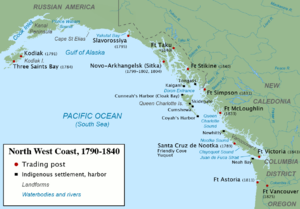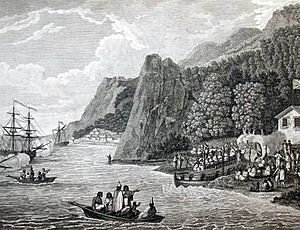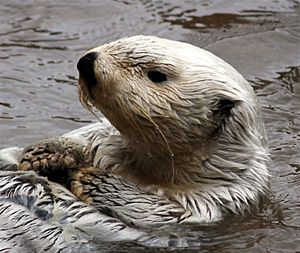Maritime fur trade facts for kids
The maritime fur trade was a special kind of fur trade that happened on ships. It was all about getting furs from sea otters and other animals. These furs were traded with indigenous peoples of the Pacific Northwest Coast and native people in Alaska. Most of the furs were then sold in China. In return, traders got things like tea, silks, and porcelain from China. These Chinese goods were then sold in Europe and the United States.
Russians were the first to start this trade. They moved east from the Kamchatka Peninsula along the Aleutian Islands to Alaska. British and American traders joined in during the 1780s. They focused on the coast of what is now British Columbia. The trade was very busy around the early 1800s. But it started to slow down in the 1810s. As the number of sea otters dropped, the trade changed. It started to include new goods and markets, but still focused on the Northwest Coast and China. This trade continued until the mid-to-late 1800s.
Russians controlled most of the coast of Alaska during this time. South of Alaska, British and American ships competed fiercely. The British started first in the southern area. But they couldn't beat the Americans, who were in charge from the 1790s to the 1830s. The British Hudson's Bay Company joined the coastal trade in the 1820s. Their goal was to make the Americans leave. They succeeded by about 1840. Towards its end, the maritime fur trade was mostly run by the British Hudson's Bay Company and the Russian-American Company.
Historians created the name "maritime fur trade." This helps tell it apart from the land-based fur trade, like the one run by the North West Company. In the past, people usually called it the "North West Coast trade."
This trade connected the Pacific Northwest coast to a huge new global trade network. This network was centered on the northern Pacific Ocean. It was based on capitalism, which is an economic system where businesses are owned by private people, not the government. It wasn't mostly about colonialism, which is when one country takes control of another. A "triangular trade" system grew, linking the Pacific Northwest coast, China, the Hawaiian Islands, Britain, and the United States (especially New England).
The trade greatly affected the native people of the Pacific Northwest coast. This included the Aleut, Alutiiq, Tlingit, Haida, Nuu-chah-nulth, and Chinook people. They gained a lot of wealth quickly. But there was also more warfare, potlatching (special ceremonies), slaving, and a drop in population due to diseases. However, their culture didn't disappear. Instead, it grew stronger. For example, totems and traditional family symbols became more important. The Chinook Jargon, a special language, also developed during this time. Native Hawaiian society was also changed by new Western wealth, technology, and diseases. The trade had little effect on China and Europe. But for New England, the big profits from the fur trade helped the region grow. It changed New England from a farming society to an industrial one. The money from the fur trade was used to build factories, especially for making cloth.
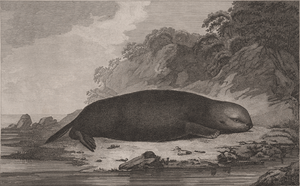
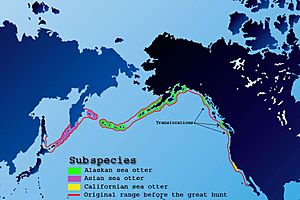
The most valuable furs came from sea otters. The northern sea otter, found from the Columbia River to the Aleutian Islands, was especially prized. Sea otters have the thickest fur of any mammal. They groom their coats, which keeps them from shedding. Their 'dark and silver tipped fur' was highly desired in China. This demand led to them being hunted almost to extinction. Today, sea otters are listed as "Threatened" in Canada. Their population used to be between 150,000 and 300,000. Sea otters are slow breeders, usually having only one or two pups at a time. This made it hard for their numbers to recover when they were hunted.
The hunting of beavers also greatly harmed their populations. The natural ecosystems that relied on beavers for dams and water were also damaged. This led to ecological destruction and dry areas. It took centuries for beaver populations to recover in some places, and some never did. The hunting also affected other Pacific Western animals like otters, fish, and bears.
Contents
How the Trade Started
The Pacific Northwest was one of the last big areas outside the polar regions to be explored by Europeans. Other parts of North America were already claimed by powerful empires. In the late 1700s and early 1800s, many empires and trading groups came to the Northwest Coast. They arrived by sea and by land. The Russian and Spanish empires expanded into the region at the same time, from different directions.
Russian Beginnings
Russian fur companies moved into North America along the Aleutian Islands. They reached the Fox Islands and the Alaska Peninsula in the early 1760s. Kodiak Island was found in 1763. In 1768, a Russian Navy trip explored the area. Reports of this trip, meant to be secret, spread in Europe. Spain became worried. Spain was already concerned about Russia in Alaska. So, they decided to settle Alta California and sent ships to Alaska to check on the threat.
Alta California was set up in 1769. By 1782, Spanish forts were built at San Diego, Monterey, San Francisco, and Santa Barbara. These were connected by missions along the coast. Spanish ships explored farther north in 1774, 1775, and 1779. In 1784, Russian activity moved east to Kodiak Island.
It seemed like Russia and Spain would clash. But before they did, new powers arrived: Britain and the United States. When a conflict happened at Nootka Sound in 1789, it was between Spain and Britain. The British first reached the area by sea in 1778 with James Cook's third voyage. They arrived by land in 1793 with Alexander Mackenzie. The first British fur trader, James Hanna, came in 1785. The first American traders, John Kendrick and Robert Gray, arrived by sea in 1788. The Lewis and Clark Expedition arrived by land in 1805.
Early fur traders were also explorers. The Northwest Coast is very complex, with many islands, straits, and fjords. It has a rocky, steep shoreline. Sailing was dangerous due to rain, strong winds, thick fogs, strong currents, and tricky tides. Early explorations only mapped the general features. Detailed maps were made in only a few small areas. British and American traders started visiting in 1785, when most of the coast was still unknown. They made many important discoveries. For example, Charles William Barkley found the Strait of Juan de Fuca. Robert Gray found Grays Harbor and the Columbia River.
Russia's Role in the Fur Trade
Russian maritime fur trading in the northern Pacific began after the voyages of Vitus Bering in 1741. These trips showed that Asia and North America were separate and that the region had many furs. Private fur traders, called promyshlenniki, started expeditions from Kamchatka. They first focused on nearby islands. Unlike fur trading in Siberia, these sea trips needed more money. Merchants from cities like Irkutsk became the main investors.
An early trader, Emilian Basov, traded at Bering Island in 1743. He collected many sea otter, fur seal, and blue Arctic fox furs. Basov made a fortune, inspiring others. From 1743 to 1799, over 100 private fur-trading trips sailed from Kamchatka to North America. They earned over eight million silver rubles. In the early years, ships would stop at the Commander Islands to hunt Steller's sea cows. These animals were hunted for food, skins (for boats), and fat (for oil lamps). By 1768, Steller's sea cow was extinct.
As furs ran out on nearby islands, Russian traders sailed farther east along the Aleutian chain. By the 1760s, they were regularly sailing to Kodiak Island. Important Russian traders included Nikifor Trapeznikov and Grigory Shelikhov.
As trips became longer and more costly, smaller companies joined together. In the 1780s, Grigory Shelikhov became a top trader with his Shelikhov-Golikov Company. In 1784, Shelikhov started the first lasting Russian settlement in North America. It was at Three Saints Bay on Kodiak Island. Shelikhov wanted to expand the Russian fur trade all the way to California. He wanted to control the trade completely. In 1788, Empress Catherine II gave his company a monopoly only where it already was. Other traders could compete elsewhere.
By 1788, when other nations joined the trade, Russians had been operating in North America for over 40 years. They had many colonies from the Aleutian Islands to Cook Inlet. Many ships sailed from Kamchatka to Alaska each year. Russians had a head start and controlled areas with the most valuable sea otters. Furs from Kuril, Kamchatka, and Aleutian sea otters were thicker and glossier than those from the Northwest Coast. Russia also controlled sable furs, the most valuable land animal fur.
The Russian system was different from the British and American ones. Russians used or enslaved Aleut and Alutiiq people. These native people were expert sea otter hunters, known for their kayaks. Russian ships mainly transported and helped native hunting groups. British and American systems were different. Native people hunted sea otters and prepared furs on their own. They were independent traders. Russians did not trade freely with native Alaskans. Instead, they demanded a fur payment called yasak. This system, used in Siberia, basically enslaved the natives. In 1788, it was banned in Russian America, but was replaced by forced labor.
Britain's Entry into the Trade
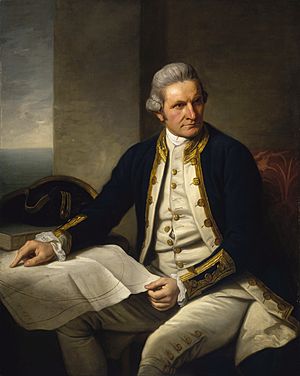
Britain joined the maritime fur trade in 1778, during Captain James Cook's third voyage. Cook found the Hawaiian Islands while looking for the Northwest Passage. On the Northwest Coast, he spent a month in Nootka Sound. He and his crew traded with the Nuu-chah-nulth people from the village of Yuquot. They got over 300 furs, mostly sea otter. They didn't think the furs were worth much. But later, after Cook died in Hawaii, the expedition visited Canton (China). They were surprised by how much money the Chinese would pay for the furs. They made a profit of 1,800%! This huge profit encouraged many British trips to the Northwest Coast.
British interest in the fur trade was highest between 1785 and 1794. Then it dropped because of the French Revolutionary Wars, which reduced Britain's available workers and money. Britain also focused its trade in India. British fur traders faced problems from the East India Company (EIC) and South Sea Company (SSC). The SSC had the sole right to British trade on the entire western coast of the Americas. The EIC had a monopoly on British trade in China. This meant British traders needed licenses from both companies, which was hard and costly. Some tried to avoid licenses by sailing under other flags. The EIC was mainly interested in tea from China, not furs. They allowed British ships to bring furs to Canton but required them to be sold through EIC agents, who took a percentage. Also, the EIC didn't let British fur traders take Chinese goods back to Britain. So, British traders missed out on the most profitable part of the trade: selling Chinese goods in Europe and America.
The first ship sent only for fur trading was the British Sea Otter in 1785. Its captain, James Hanna, got 560 pelts. They sold for a $20,000 profit in Canton. This promise of profit encouraged others. George Dixon and Nathaniel Portlock, who had been on Cook's crew, formed the King George's Sound Company in 1785. They sailed from England and spent 1786 and 1787 trading on the North West Coast. They spent winters in Hawaii.
Charles William Barkley, another early British trader, sailed the Imperial Eagle from England to the North West Coast. His wife, Frances Barkley, was with him. She became the first European woman to visit Hawaii and the first woman to sail around the world without hiding her identity. Barkley sailed under the flag of Austria to avoid paying for licenses. In Hawaii, the Barkleys hired a native Hawaiian named Winée as a maid. Winée was the first native Hawaiian to visit the Pacific Northwest. Barkley explored the coast south of Nootka Sound and found the Strait of Juan de Fuca. He was the first trader to visit Neah Bay, which became an important stop for fur traders.
John Meares, who also served under Cook, sailed to the North West Coast in 1786. He spent a winter trapped by ice in Prince William Sound, and his men got sick. He was rescued by Dixon and Portlock. Meares organized a second trip. He claimed that Chief Maquinna sold him land at Nootka Sound, where Meares built a building. These claims later caused problems during the Nootka Crisis. Spain, which wanted control of Nootka Sound, rejected these claims. However, Meares did build the sloop North West America at Nootka Sound. This was the first non-native ship built in the Pacific Northwest.
Meares and others planned another trip the next year. Several ships sailed to Nootka Sound. James Colnett planned to build a permanent fur-trading post there. But Spain also decided to take Nootka Sound and claim the North West Coast. Spanish officer Esteban José Martínez arrived at Nootka in May 1789 and built Fort San Miguel. When Colnett's ship arrived, a fight started between Colnett and Martínez. Several British ships were seized, and their crews arrested. This led to the Nootka Crisis, a big problem between Britain and Spain. War was avoided with the first Nootka Convention in 1790.
American Traders Join In
American traders were greatly influenced by a report published by John Ledyard in 1783. By the 1790s, American traders were outperforming the British. They soon became the main force in the maritime fur trade south of Russian America. The start of this trade was good for New England's merchants. It helped them escape the economic downturn after the American Revolutionary War. It offered new trading chances that made up for British ports being closed to US goods. Native groups along the coast called American traders "Boston-men" because many came from Boston.
One of the first and most famous American fur traders was Robert Gray. Gray made two trading voyages. The first was from 1787 to 1790 with John Kendrick. They used the ships Columbia Rediviva and Lady Washington. After the 1789 fur trading season, Gray sailed the Columbia to China, then to Boston. The Columbia's arrival in Boston was celebrated as the first American ship to sail around the world. However, the trip wasn't very profitable. The ship's owners paid for a second attempt.
Gray's second voyage was important in several ways. After trading on the Northwest Coast, Gray spent the winter there. In Clayoquot Sound, Gray's crew built a house, called Fort Defiance. They also built the sloop Adventure, the first American ship built on the Northwest Coast. During the 1792 trading season, Gray focused on the southern part of the coast, including the Columbia River. Although the river's mouth was seen by a Spanish explorer in 1775, no one else had found it and entered. Gray was the first to do so. He named the river after his ship. This event was later used by the United States to support its claims to the Pacific Northwest.
Other important American fur traders included William F. Sturgis, Joseph Ingraham, and John Boit. One of the most successful American companies was Perkins and Company.
Busy Years of the Trade
American Dominance
American traders controlled the maritime fur trade from the 1790s to the 1820s. Between 1788 and 1826, American merchant ships made at least 127 trips between the United States and China, stopping at the Northwest Coast. The profits were very good. In the late 1810s, traders could earn 300% to 500% profit on their investment. Even higher profits were common in the early 1800s, sometimes 2,200% or more.
The busiest years ended around 1810. After that, the trade slowly declined, and businesses started to offer more types of goods. By 1810, there were fewer sea otter pelts because of too much hunting. American trade slowed during the War of 1812. But after 1815, Americans were able to restart and expand the trade, and they kept their lead.
Russian Expansion
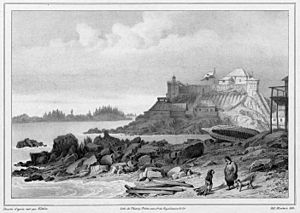
Russian expansion to the Northwest Coast, beyond Prince William Sound, was slow because they didn't have enough ships and sailors. Yakutat Bay was reached in 1794. A settlement called Slavorossiya was built there in 1795. In 1795, Alexandr Baranov sailed into Sitka Sound and claimed it for Russia. Hunting groups arrived in the following years. By 1800, three-quarters of the Russian-American Company's sea otter skins came from the Sitka Sound area. This was also where Russians, British, and Americans first seriously competed.
In July 1799, Baranov returned to Sitka Sound and built the settlement of Arkhangelsk. In June 1802, Tlingit warriors attacked the settlement. They killed or captured most of the 150 Russians and Aleuts living there. Baranov led an armed group to retake Sitka in June 1804. The Russian warship Neva joined Baranov. A new Russian fort was built. The Tlingit prepared to defend themselves with their own strong fort. Tensions grew, and talks failed. In early October, Russians attacked the Tlingit fort with cannons from the Neva and from land. The Tlingit fought back with their own powerful guns and cannons. The Battle of Sitka lasted several days until the Tlingit left their fort. The Russians destroyed the Tlingit fort and named their new fort Novo-Arkhangelsk (New Archangel). The battles at Sitka in 1802 and 1804 greatly affected Tlingit-Russian relations for many years.
Novo-Arkhangelsk soon became the main settlement and capital of Russian America. After the Alaska Purchase, it was renamed Sitka.
The Russian-American Company (RAC) was formed in 1799. This ended the period of private traders and started a time of centralized control. Its rules were set by a 1799 proclamation from Tsar Paul. It gave the company control over trade in the Aleutian Islands and mainland North America, south to 55° north latitude (near the current border between British Columbia and Alaska). The RAC was similar to Britain's East India Company and Hudson's Bay Company. Russian officials wanted it to be both a business and a way to expand the empire. In 1818, the Russian government took control of the RAC from the merchants. In 1867, the Alaska Purchase transferred control of Alaska to the United States.
The Russian population in America never went above 1,000 people. However, the RAC employed and fed thousands of native people.
Changes in the Trade
Russian-American Company's Outposts
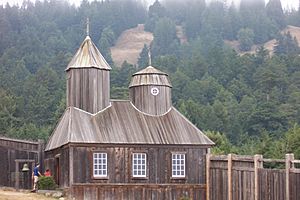
Colony Ross, now known as Fort Ross, was built in California, north of San Francisco Bay. It was the RAC's southernmost outpost. It operated from 1812 to 1841. It was set up to grow food for the northern settlements and to trade with Alta California. Fort Ross used native Alaskans to hunt seals and sea otters on the California coast. By 1840, California's sea otter population was almost gone.
The Russian Emperor Alexander I issued a proclamation in 1821. It said Russia controlled the Northwest Coast from 45°50′ north latitude northward. The only time Russia tried to enforce this was when they seized the US ship Pearl in 1822. The Pearl was a fur trading ship sailing from Boston to Sitka. After the US government protested, the ship was released, and money was paid. Britain and the United States also protested. This led to the Russo-American Treaty of 1824 and the Anglo-Russian Convention of 1825. These treaties set 54°40′ as the southern border of Russian territory. This is mostly the current border of Alaska. In 1839, the RAC made a deal with the Hudson's Bay Company (HBC). The HBC leased parts of the Alaska Panhandle for ten years.
American Trading Methods
American traders developed a "Golden Round" trade route around the world. Ships sailed from Boston to the Pacific, then to the North West Coast, arriving in spring or early summer. They spent the summer and early autumn trading furs, mainly between Sitka and the Columbia River. In late autumn, they sailed to the Hawaiian Islands for the winter. Then, from Hawaii, they went to Macau in China, arriving in autumn. Trading in Canton (China) started in November when tea was ready. The Americans had to hire pilots to take their ships up the Pearl River to Whampoa, Canton's "outport." Foreign ships weren't allowed in Canton itself.
Trading took weeks or months. Ships were loaded with Chinese goods like teas, silks, porcelain, and sugar. They left in winter, using monsoon winds to cross the South China Sea and Indian Ocean. From there, they sailed to Boston. This was called the "golden round" because of the multiple profits: first, from trading goods for furs; second, from selling furs for Chinese goods; and third, from selling Chinese goods in America. Later, the trade became more complex with more markets and side trips.
As the North West trade grew, it became risky to rely only on sea otter furs. Businesses started to offer more types of goods in the early 1800s. Other goods and markets across the Pacific were added. Sandalwood, mainly from Hawaii, became important for trade with China. Just as the sea otter trade was ending, the sandalwood trade boomed, peaking in 1821. Hawaiian sandalwood was used up by 1830. Fiji was another source of sandalwood and also bêche-de-mer, a Chinese food. American traders started getting bêche-de-mer from Fiji in 1804. Other side trades included copper from Chile, whale teeth, tortoise shells from the Galápagos Islands, sugar from Manila, and coffee beans from Java. Sealing boomed in the Juan Fernández Islands, and the Juan Fernández fur seal was quickly hunted almost to extinction.
Another side trade was smuggling along the Pacific coast of the Spanish Empire. Spanish law banned foreign trade there. This trade was highest in the 1810s. Traders focused on Alta California, which had extra grain, beef, and hides, but lacked manufactured goods. American ships brought goods to the missions of Alta California for grain, beef, and Californian sea otter skins. The food went to Sitka, which always needed supplies. After Mexico became independent in 1821, American trade with Alta California continued. American traders brought clothes, cottons, silks, and alcohol. They traded these for hides and tallow, making 200% to 300% profit. The California hide trade became a big industry. But by the 1830s, the missions were closed, and the trade became unprofitable. The decline of American trade with Alta California left only one big alternative: supplying Russian America. This lasted until Americans left the North West Coast in the early 1840s. From the early 1800s until 1841, American ships visited Sitka regularly. They traded supplies and liquor for fur seal skins, timber, and fish. This trade was very profitable for Americans, and Russian settlements depended on it. So, when Tsar Nicholas I banned foreign trade north of the 51st parallel in 1821, the Russian colonies had to ignore it and smuggle goods.
On the Northwest Coast, the fur trade also included slave trading. The existing native slave trade grew bigger with the help of fur traders, especially Americans. Traders bought slaves near the Columbia River and in the Strait of Juan de Fuca. Then they sold or traded them on the northern coast. Few traders admitted to this, but some wrote about it. Reports from Hudson's Bay Company officers also confirm it. An HBC officer wrote in 1828 that American traders made more money selling slaves, rum, and gunpowder than from furs.
The Chinese wanted sea otter fur because of its high value and 'prime coat' all year. Wealthy Chinese used the pelts for clothing decoration. Russians used them as ornaments. Other furs sent to Europe and America were used for 'coat collars or hats'. Because of this high demand, the Russian-American Company's yearly expenses were around 1,000,000 rubles, and they profited over 500,000 rubles per year. The fur of the Californian southern sea otter was less valued. After the northern sea otter was hunted to local extinction, traders moved to California until the southern sea otter was also nearly extinct. British and American traders took their furs to Guangzhou (Canton), China. Furs from Russian America were mostly sold to China through the Mongolian town of Kyakhta.
Decline of the Trade
Big economic problems led to the decline of the maritime fur trade and the China trade. Before the 1800s, China didn't demand many Western goods. But they accepted bullion (gold and silver), which meant precious metals flowed from the West to China. This changed in the early 1800s. Western demand for Chinese goods dropped, while Chinese demand for Western goods like English manufactures increased. Soon, China was losing precious metals and had too many Western goods.
At the same time, there was a lot of risky investing in the China trade by American and British companies. By the 1820s, too many companies were competing in a market with too many goods. This led to bankruptcies and companies joining together. A financial crisis hit in 1826–27. Tea prices fell sharply, and the volume of China trade dropped by about a third. By this time, the old maritime fur trade on the Northwest Coast was dying. The final blow came with the economic downturn of 1841–43.
Over time, fur traders focused on different parts of the North West Coast. In the 1790s, they visited the west coast of Vancouver Island often. By the 1810s, they moved to the Queen Charlotte Islands. In the 1820s, they went farther north near Sitka Sound. After about 1830, they shifted south to the area from Dixon Entrance to Queen Charlotte Sound. In the early years, ships sailed along the coast looking for trade. Later, they spent more time in specific harbors. As furs became scarce and prices rose, ship captains stayed longer in a few key ports. Eventually, it was impossible to get enough furs for the China trade in one year. Some traders spent winters in Hawaii, returning to the coast in spring. But many wintered on the North West Coast in key trading harbors. These included "Clemencitty" (Port Tongass), "Kaigani" harbors, "Nahwitti" on Vancouver Island, and "Tongass" (Tamgas Harbor). Many important trading sites were on the Queen Charlotte Islands.
As marine furs became scarce in the early 1800s, American ship captains started accepting more land furs like beaver. These came from the interior to the coast through native trade networks. In the 1820s, the British Hudson's Bay Company (HBC), which controlled the interior fur trade, started losing money because these furs were going to the coast. To protect its business, the HBC joined the coastal trade to drive away American traders. They succeeded in the 1830s. By 1841, American traders had left the North West Coast. For a time, the North West Coast trade was controlled by the HBC and the RAC. After the Oregon boundary dispute was settled in 1846, and the American purchase of Alaska in 1867, American hunters returned to hunting sea otters. This hunting, along with that in the Aleutian and Kuril Islands, led to the near-extinction of the species by the late 1800s.
Hudson's Bay Company's Strategy
From 1779 to 1821, two British fur trading companies, the North West Company (NWC) and the Hudson's Bay Company (HBC), fought for control of the fur trade in what is now Western Canada. This fight even involved armed battles. Around 1800, the NWC expanded west into the Pacific Northwest. By the 1810s, the NWC had new fur trading operations west of the Rocky Mountains. In 1811, the American Pacific Fur Company (PFC) challenged the NWC. But during the War of 1812, the PFC sold its operations to the NWC. The PFC had built Fort Astoria at the mouth of the Columbia River. The NWC renamed it Fort George. The NWC wanted to trade beaver furs profitably with China. Because the East India Company controlled British trade in Canton, the NWC used American shipping companies. Starting in 1792, the NWC had American firms ship beaver furs to China. After getting Fort George in 1815, the NWC supplied the Columbia District by sea through the American firm Perkins and Company. The American ship would take NWC beaver furs to Canton, trade them for Chinese goods, and bring them to Boston to sell. Even though Perkins and Company took 25% of the profits, this was still about 50% more profitable than using British ships.
In 1821, the NWC was forced to merge with the HBC. The HBC then got the Columbia District and its trade with China. At first, they continued shipping furs through Perkins and Company. But in 1822, the United States Customs Service put a heavy tax on the profits. The HBC stopped using American middlemen and tried selling furs through the East India Company. This didn't work well for either company.
After the merger, George Simpson reorganized the HBC's operations. His efforts, along with more American traders on the coast after the Russo-American Treaty of 1824, led the HBC to join the coastal fur trade to drive out the Americans. By the early 1820s, American traders were taking 3,000 to 5,000 beaver skins to Canton each year. By the early 1830s, this number reached 10,000 annually. This was as many as the HBC got from New Caledonia. Americans were also paying higher prices for furs, forcing the HBC to do the same.
The HBC's effort to control the coastal fur trade began in the late 1820s. It took time for the HBC to get the ships, sailors, and goods needed. Simpson decided that the "London ships," which brought goods to Fort Vancouver, should arrive early enough to make a coastal trip before returning to England. The first ship to do this was the schooner Cadboro in 1827. However, it didn't go far and got few furs. In 1828, the HBC decided to use three ships for the coastal trade, but there were delays. Two ships were lost in 1829 and 1830. The HBC's shipping was not enough until the mid-1830s. In 1835, two more ships were added. One of them, the Beaver, was a steamship. It was very useful in the tricky winds and currents of the coast.

To strengthen its coastal trade, the Hudson's Bay Company built a series of fortified trading posts. The first was Fort Langley, built in 1827 on the Fraser River. The next was Fort Simpson, founded in 1831. In 1833, Fort McLoughlin was built, and Fort Nisqually was built at the southern end of Puget Sound. An overland trail linked Fort Nisqually and Fort Vancouver. This meant HBC ships trading along the northern coast could unload furs and take on goods without having to navigate the dangerous Columbia River. Later coastal posts included Fort Stikine (1840) and Fort Victoria (1843).
Why Americans Lost Their Edge
It was hard for the HBC to push Americans out of the North West Coast. Americans had decades of experience and knew the coast well. It took until 1835 for the HBC to gain this much experience. But Americans still had advantages. They were willing to pay high prices for furs, much higher than the HBC could match without losing a lot of money. American businesses were global. They used many markets, and the North West Coast was just one of them. By the 1820s, American ships often spent years in the Pacific, making several trips between places like California, Hawaii, and China. American ships usually had extra trade goods for the North West Coast. It was always best to sell any extra goods there, even at a low price, before leaving. This freed up space for more profitable goods. So, the HBC faced a big challenge. The American system not only raised fur prices but also lowered the value of trade goods. Also, native people knew that more competition helped them get better deals. They didn't want Americans to leave the trade. So, the HBC had to pay even more than Americans if they wanted to drive them away. Beaver fur prices on the coast could be many times what the HBC paid inland. There was no hope of making a profit. To compete, the HBC had to accept big, long-term financial losses.
The main advantage the HBC had was that it could afford these losses. As a large company with a lot of money, it could sell goods cheaper than Americans, losing money for years. By the mid-to-late 1830s, the HBC's policy on the coast was to pay whatever price necessary to ensure that furs fell into their hands and not the Americans. American traders soon found the coast fur trade unprofitable. The HBC had captured the trade. But Americans still traded with the Russians at Sitka and, once on the coast were wont to seek a few furs. As long as this continued, the HBC continued to have to pay high prices for furs and take losses. Eventually the Sitka trade became financially risky. The American-Russian agreement of 1824, which allowed Americans to trade in the Alaska Panhandle, expired in 1834 and was not renewed. In 1839, the HBC made an agreement with the Russian American Company (RAC). The HBC would supply the RAC with goods in exchange for a ten-year lease of parts of the Alaska Panhandle. This was the final blow for American traders. They were finally driven out of the North West Coast maritime fur trade completely.
The HBC greatly lowered the price paid for furs, by 50% in many cases. By this time, however, the fur trade was declining, both on the coast and inland. This was due to fewer fur-bearing animals and less demand for beaver pelts. A financial crisis in 1837 led to a general slump in the fur and China trade, ending a half-century of growth. In the 1840s, the HBC closed most of its coastal trading posts. The coastal trade was left to just Fort Simpson and the Beaver, with the new depot at Fort Victoria.
Why the Trade Was Important
The maritime fur trade, lasting about 50 years, made Boston shipowners rich. This money helped New England change from a farming society to an industrial one. The trade boosted the culture of Northwest Coast natives. It made Hawaii famous and greatly changed native Hawaiians with foreign influences. It also increased trade pressure on China. Fur-bearing animals, especially sea otters, were greatly harmed. By 1850, sea otters were almost extinct throughout the North West Coast. They were only found in the Aleutian Islands and California.
Impact on the Northwest Coast

The maritime fur trade brought native people of the Northwest Coast more goods, wealth, and technology. It changed and expanded trade and warfare between tribes. Many inland native groups adopted potlatching and coastal family systems. At first, the trade increased the power of a few key chiefs like Maquinna. Then, there were more chiefs, and the importance of chieftainship lessened. This was partly because widespread wealth allowed individual hunters to challenge traditional chiefs. Potlatching became more frequent. New rich people used it to challenge traditional chiefs. In response, hereditary clan chiefs defended their power by using noble ancestry names, totems, and crests, all confirmed by potlatches.
The increase in trade and new items greatly affected First Nations' material culture. Traditions like fabric appliqué (Button Blankets) and metalwork (engraved silver jewelry) grew. It also led to more creative art with better (iron) tools, resulting in more and larger carvings (like 'totem poles'). New colors like vermilion from China quickly replaced older red pigments.
Negative effects of the coastal trade on native peoples included waves of diseases, especially smallpox. Other health problems included the spread of alcoholism, tuberculosis, and infertility. The trade also increased the existing system of native slavery. The total number of slaves grew, as did their use. Despite these negative effects, North West Coast natives largely avoided more permanent settlements, political control, and colonization. Early traders were mostly seasonal visitors. The later HBC posts were few and small. Christian missions and direct colonial rule over coastal natives didn't truly begin until the late 1800s. In the early 1800s, native culture not only survived but thrived.
The maritime trade also changed native seasonal migration patterns and settlement locations. The coastal people were "cosmopolitanized," that is, they were included in a global market economy. At first, their main export was furs. Later, salmon, lumber, and artwork were added. By the late 1800s, the North West Coast was famous for its arts and crafts, especially large works like totem poles. This led to a flourishing of native art. Natives imported many Western goods and soon depended on many, like firearms and metal tools. Textiles became a vital trade item. The value of furs caused a shift in native dress from furs to textiles, also because fur animals became scarce. Firearms had both good and bad effects. They made hunting more efficient but also made warfare much deadlier.
Impact on Russian America
Unlike the British and Americans, Russians tried to convert native people to Christianity. Many Aleuts joined the Russian Orthodox Church. Russian missionaries built churches for native people. A famous Russian missionary was Saint Innocent of Alaska. He was made a saint for his work in Alaska and the Russian Far East. One of the first Christian martyrs in North America was Saint Peter the Aleut. Other important Russian missionaries included Herman of Alaska and Joasaph Bolotov.
Impact on Hawaii
The maritime fur trade affected native Hawaiians similarly to the Northwest Coast natives, but with bigger changes. Hawaiians generally welcomed Western visitors and settlers. The rise of King Kamehameha I and the unification of the islands under his rule were partly possible because of the maritime fur trade. The new Kingdom of Hawaii became relatively strong politically and economically due to the influx of wealth and technology. Many non-native foods were brought to the Hawaiian Islands during this time. These included plants like beans, cabbage, onions, and melons, as well as cash crops like tobacco and sugar. Animals like cattle, horses, sheep, and goats were also introduced. Because of its fertile land, Oahu became the most important island. By the 1820s, the population of Honolulu was over 10,000. The native Hawaiian population suffered from waves of diseases, including cholera. These health problems, plus warfare, droughts, and focusing on sandalwood instead of farming, led to more famines and a general population decline. By 1850, the native population had dropped by about 50%.
Impact on New England
For the United States, the maritime fur trade was part of the "East India" (Asian) trade. This trade was based in cities like Salem, Boston, and New York City. It focused on Asian ports like Canton, Kolkata, and Manila. Goods exported included furs, rum, ammunition, and tobacco. Goods brought back from Asia included silks, porcelain, tea, and sugar. The maritime fur trade was just one part of this larger system. Overall, the Asian trade greatly affected the early United States, especially New England. The quick accumulation of large amounts of money helped American industrial and manufacturing growth. This was combined with rapid population growth and new technologies. In New England, the textile industry became dominant in the early to mid-1800s. As the fur trade declined and after an economic downturn, money shifted "from wharf to waterfall." This means it moved from shipping businesses to textile mills, which were built where water power was available. The textile industry, in turn, greatly affected slavery in the United States. It increased the demand for cotton, which helped the rapid expansion of cotton plantations in the Deep South.
See also
 In Spanish: Comercio marítimo de pieles para niños
In Spanish: Comercio marítimo de pieles para niños


